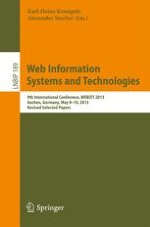This book contains the thoroughly refereed and revised best papers from the 9th International Conference on Web Information Systems and Technologies, WEBIST 2013, held in Aachen, Germany, in May 2013, organized by the Institute for Systems and Technologies of Information, Control and Communication (INSTICC), and co-organized by the RWTH Aachen University.
The 15 papers presented in this book were carefully reviewed and selected from 143 submissions. The papers were selected from those with the best reviews also taking into account the quality of their presentation at the conference. The papers are grouped into parts on Internet technology, Web interfaces and applications, society, e-business and e-government, Web intelligence, and mobile information systems.
